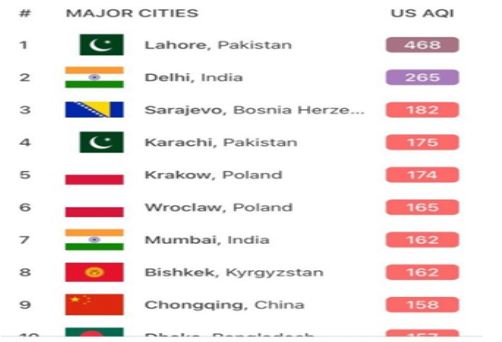Analysing and Enhancing the Level of Awareness about Air Quality among the Teenagers to Achieve Healthier Environment in Lahore
Abstract
 Abstract Views: 0
Abstract Views: 0
Urban areas have witnessed a rapid increase in population all around the globe during the last few decades. Pakistan has also experienced rapid urbanization which has depleted available resources and created many challenges. These include an unplanned urban sprawl, long travel distances within the city, and the destruction of natural environment. Undoubtedly, among all the issues the city of Lahore is currently facing, poor air quality appears at the top of the list. The deprivation of trees and agricultural land, pollution generated by the construction of housing societies and road networks, and smoke emitted from motor vehicles and factories are some of the major factors contributing to air pollution in Lahore. The study aims to assess the air pollution awareness among the teenagers of Lahore city. Keeping in view the fact that air pollution has increased cardiac and respiratory diseases, it is important to educate the masses to improve air quality for a healthier and liveable environment. The government should introduce more effective legislation to control pollution; however, it needs consistent support from citizens, architects, builders, and all other stakeholders for its successful implementation. Educational institutions and media can play a significant role in creating awareness through education and positive campaigning. At the end, the study discusses how people can positively contribute to the solution when they come to know the intensity of the problem and its harmful effects.
Downloads
References
Beaumont, R., Hamilton, R. S., Machin, N., Perks, J., & Williams, I. D. (1999). Social awareness of air quality information. Science of the Total Environment, 235(1-3), 319–329. https://doi.org/10.101/S0048-9697(99)00215-6
Cisneros, R., Brown, P., Cameron, L., Gaab, E., Gonzalez, M., Ramondt, S., Veloz, D., Song, A., & Schweizer, D. (2017). Understanding public views about air quality and air pollution sources in the San Joaquin Valley, California. Journal of Environmental and Public Health, 2017, Article e 4535142. https://doi.org/10.1155/2017/4535142
Franceschini, F., Galetto, M., & Maisano, D. (2005). A short survey on air quality indicators: properties, use, and (mis) use. Management of Environmental Quality: An International Journal, 16(5), 490–504. https://doi.org/10.1108/14777830510614358
Fuller, R., Landrigan, P. J., Balakrishnan, K., Bathan, G., Blüml, S., Bräuer, M., Caravanos, J., Chiles, T., Cohen, A., Corra, L., Cropper, M., Ferraro, G., Hanna, J. L., Hanrahan, D., Hu, H., Hunter, D., Janata, G., Kupka, R., Lanphear, B. P., . . . Yan, C. (2022). Pollution and health: A progress update. The Lancet Planetary Health, 6(6), e535–e547. https://doi.org/10.1016/s2542-5196(22)00090-0
Güç, F. A., Aygün, M., Ceylan, D., Güngören, S. Ç., Durukan, Ü. G., Hacioğlu, Y., & Yekeler, A. D. (2018). Air pollution awareness in the scope of the community service practices course: an interdisciplinary study. International Electronic Journal of Environmental Education, 8(1), 35–63.
Hayes, E., Chatterton, T., & Laxen, D. (2009). Questionnaire survey of UK Local Authorities on the local air quality management process. UWE/AQCC, Bristol. www.scottishairquality.scot/sites/default/files/orig/publications/reports2/271100318_laqm-questionnaire-review.pdf
Kader, P. (1994). Questionnaires: use, value and limitations. Nurse Researcher, 1(2), 4–15. https://doi.org/10.7748/nr.1.2.4.s2
Kim, Y., Knowles, S., Manley, J., & Radoias, V. (2017). Long-run health consequences of air pollution: Evidence from Indonesia's forest fires of 1997. Economics & Human Biology, 26, 186–198. https://doi.org/10.1016/j.ehb.2017.03.006
Lee, B. J., Kim, B., & Lee, K. (2014). Air pollution exposure and cardiovascular disease. Toxicological Research, 30, 71–75. https://doi.org/10.5487/TR.2014.30.2.071
Oltra, C., & Sala, R. (2018). Perception of risk from air pollution and reported behaviors: A cross-sectional survey study in four cities. Journal of Risk Research, 21(7), 869–884. https://doi.org/10.1080/13669877.2016.1264446
Ramírez, A. S., Ramondt, S., van Bogart, K., & Perez-Zuniga, R. (2019a). Public awareness of air pollution and health threats: Challenges and opportunities for communication strategies to improve environmental health literacy. Journal of Health Communication, 24(1), 75–83. https://doi.org/10.1080/10810730.2019.1574320
Riley, R., de Preux, L., Capella, P., Mejia, C., Kajikawa, Y., & de Nazelle, A. (2021). How do we effectively communicate air pollution to change public attitudes and behaviours? A review. Sustainability Science, 16, 2027–2047. https://doi.org/10.1007/s11625-021-01038-2
Smallbone, K. (2012). Individuals’ interpretation of air quality information. School of Environment and Technology, University of Brighton. https://core.ac.uk/download/pdf/188253313.pdf
Wiederkehr, P., & Yoon, S. J. (1998). Air quality indicators. In J. Fenger, O. Hertel, & F. Palmgren (Eds.), Urban Air Pollution—European Aspects (pp. 403–418). Springer.
World Health Organization. (2000). Air quality guidelines for Europe (2nd ed.). World Health Organization. https://www.who.int/publications/i/item/9789289013581

Copyright (c) 2023 Hina Nabeel, Qudsia Asif, Syed Nabeel Hassan

This work is licensed under a Creative Commons Attribution 4.0 International License.
JAABE follows an open-access publishing policy and full text of all published articles is available free, immediately upon publication of an issue. The journal’s contents are published and distributed under the terms of the Creative Commons Attribution 4.0 International (CC-BY 4.0) license. Thus, the work submitted to the journal implies that it is original, unpublished work of the authors (neither published previously nor accepted/under consideration for publication elsewhere). On acceptance of a manuscript for publication, a corresponding author on the behalf of all co-authors of the manuscript will sign and submit a completed Copyright and Author Consent Form.
Copyright (c) The Authors





